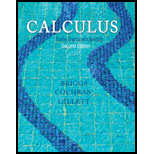
Explain why or why not Determine whether the following statements are true and give an explanation or counterexample.
a. The rotational field F = 〈–y, x〉 has zero curl and zero divergence.
b. ▿ × ▿ϕ = 0
c. Two
d. Two vector fields with the same divergence differ by a constant vector field.
e. If F = 〈x, y, z) and S encloses a region D, then
a.
To explain: Whether the given statement is true or not.
Answer to Problem 1RE
The statement is false.
Explanation of Solution
Given statement:
The rotational field
Calculation:
The given rotational field
Assume
The curl is
Substitute
Thus, the curl is 2.
Hence, the statement is false.
b.
To explain: Whether the given statement is true or not.
Answer to Problem 1RE
The statement is true.
Explanation of Solution
Given statement:
The following
Calculation:
The given statement is
Here,
Hence,
It is known that the curl of a conservative field is zero.
Hence,
Therefore, the statement is true.
c.
To explain: Whether the given statement is true or not.
Answer to Problem 1RE
The statement is false.
Explanation of Solution
Given statement:
Two vector fields with the same curl differ by a constant vector field.
Calculation:
Consider the rotational field
Assume
The curl is
Substitute the values
Thus, the curl is 2.
Consider the vector field
Assume
The curl is
Substitute the values
Thus, the curl is 2.
Hence, the vector fields
Thus, the statement is false.
d.
To explain: Whether the given statement is true or not.
Answer to Problem 1RE
The statement is false.
Explanation of Solution
Given statement:
Two vector fields with the same divergence differ by a constant vector field.
Calculation:
Consider the rotational field
Obtain the divergence.
Thus, the divergence is 1.
Consider the rotational field
Obtain the divergence.
Thus, the divergence is 1.
Hence, the vector fields
Thus, the statement is false.
e.
To explain: Whether the given statement is true or not.
Answer to Problem 1RE
The statement is true.
Explanation of Solution
Given statement:
If
Theorem Used:
Divergence theorem:
Let F be a vector field whose components have continuous first partial derivatives in a connected and simply connected region D in
Calculation:
Consider the rotational field
Compute the divergence of F.
Use the Divergence theorem stated above that obtains the value of
Thus, the statement is true.
Want to see more full solutions like this?
Chapter 14 Solutions
Calculus: Early Transcendentals (2nd Edition)
Additional Math Textbook Solutions
A Problem Solving Approach To Mathematics For Elementary School Teachers (13th Edition)
Elementary Statistics (13th Edition)
Calculus: Early Transcendentals (2nd Edition)
Elementary Statistics
University Calculus: Early Transcendentals (4th Edition)
Calculus for Business, Economics, Life Sciences, and Social Sciences (14th Edition)
- Suppose that f(x, y, z) = (x − 2)² + (y – 2)² + (z − 2)² with 0 < x, y, z and x+y+z≤ 10. 1. The critical point of f(x, y, z) is at (a, b, c). Then a = b = C = 2. Absolute minimum of f(x, y, z) is and the absolute maximum isarrow_forwardThe spread of an infectious disease is often modeled using the following autonomous differential equation: dI - - BI(N − I) − MI, dt where I is the number of infected people, N is the total size of the population being modeled, ẞ is a constant determining the rate of transmission, and μ is the rate at which people recover from infection. Close a) (5 points) Suppose ẞ = 0.01, N = 1000, and µ = 2. Find all equilibria. b) (5 points) For the equilbria in part a), determine whether each is stable or unstable. c) (3 points) Suppose ƒ(I) = d. Draw a phase plot of f against I. (You can use Wolfram Alpha or Desmos to plot the function, or draw the dt function by hand.) Identify the equilibria as stable or unstable in the graph. d) (2 points) Explain the biological meaning of these equilibria being stable or unstable.arrow_forwardFind the indefinite integral. Check Answer: 7x 4 + 1x dxarrow_forward
- Find the indefinite integral. Check Answer: In(5x) dx xarrow_forwardFind the indefinite integral. Check Answer: 7x 4 + 1x dxarrow_forwardHere is a region R in Quadrant I. y 2.0 T 1.5 1.0 0.5 0.0 + 55 0.0 0.5 1.0 1.5 2.0 X It is bounded by y = x¹/3, y = 1, and x = 0. We want to evaluate this double integral. ONLY ONE order of integration will work. Good luck! The dA =???arrow_forward
- Algebra & Trigonometry with Analytic GeometryAlgebraISBN:9781133382119Author:SwokowskiPublisher:Cengage
 Elementary Linear Algebra (MindTap Course List)AlgebraISBN:9781305658004Author:Ron LarsonPublisher:Cengage Learning
Elementary Linear Algebra (MindTap Course List)AlgebraISBN:9781305658004Author:Ron LarsonPublisher:Cengage Learning Algebra and Trigonometry (MindTap Course List)AlgebraISBN:9781305071742Author:James Stewart, Lothar Redlin, Saleem WatsonPublisher:Cengage Learning
Algebra and Trigonometry (MindTap Course List)AlgebraISBN:9781305071742Author:James Stewart, Lothar Redlin, Saleem WatsonPublisher:Cengage Learning  Linear Algebra: A Modern IntroductionAlgebraISBN:9781285463247Author:David PoolePublisher:Cengage Learning
Linear Algebra: A Modern IntroductionAlgebraISBN:9781285463247Author:David PoolePublisher:Cengage Learning



